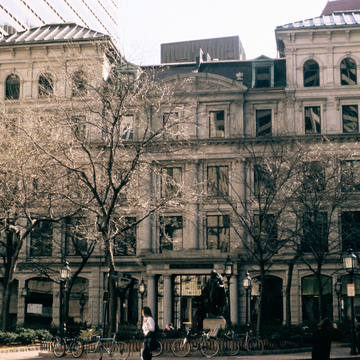The commercial block at 1 Winthrop Square, one of the most unusual structures built after the Great Boston Fire of 1872, dominates the small square. William Ralph Emerson and Carl Fehmer based their design on the Lustschloss, a Renaissance palace in Dresden, probably familiar to Fehmer, who was born in Mecklenburg, Germany, and came to this country in 1858. Replacing another commercial palace destroyed in the fire, the architects responded to concerns for improved fireproofing by using granite construction and selecting a standing seam metal hipped roof, originally with ornamental cresting, instead of the popular mansard roof, thought to be a conduit for fire. This block of stores was constructed for James M. Beebe and William F. Weld, two wealthy Boston developers. The same firm designed the block behind this structure, which extends down Otis Street to Summer.
You are here
1 Winthrop Square
If SAH Archipedia has been useful to you, please consider supporting it.
SAH Archipedia tells the story of the United States through its buildings, landscapes, and cities. This freely available resource empowers the public with authoritative knowledge that deepens their understanding and appreciation of the built environment. But the Society of Architectural Historians, which created SAH Archipedia with University of Virginia Press, needs your support to maintain the high-caliber research, writing, photography, cartography, editing, design, and programming that make SAH Archipedia a trusted online resource available to all who value the history of place, heritage tourism, and learning.


